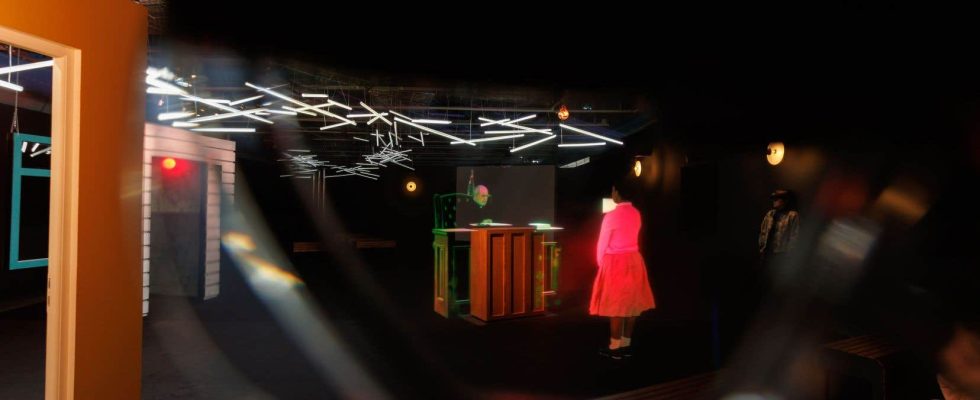Black. The little-known life of Claudette Colvin
The whole world knows Rosa Parks for her fight against racial segregation in the United States, but what about Claudette Colvin, this 15-year-old Afro-descendant teenager who refused to give up her seat to a white passenger on public transport? common from Montgomery, Alabama, in 1955, a few months before her? Very few people, as French author Tania de Montaigne observed in her biographical essay published in 2015, which was adapted by directors Stéphane Foenkinos and Pierre-Alain Giraud into an immersive experience in augmented reality. This one – as captivating as it is moving – blurs the lines between past and present and takes visitors directly alongside the anonymous Claudette Colvin on this bus journey which earned her a stay behind bars and a conviction.
“I am a former English teacher specializing in American civil rights and I had never heard of Claudette Colvin,” remembers Stéphane Foenkinos, who was able to communicate with this forgotten woman of history during a rare interview by videoconference. And continued: “We asked her if she had any resentment towards Rosa Parks, who took care of Claudette during her trial and eventually found herself in the light. She only told us that she would not have been a good example…” Today, the two co-directors therefore want to highlight the essential role of the one who still survives Rosa Parks, Malcolm X and Martin Luther King in the advancement of civil rights in the United States. As a reminder, Claudette Colvin only recently obtained a criminal record suspension. “She told us with a smile that she was tired of being a delinquent at her age,” notes Stéphane Foenkinos.
This rehabilitation also involves correctly naming Claudette Colvin, whom many at the time wrongly called “Claudette Colbert”, who is in fact a white Hollywood actress who worked with Frank Capra, Douglas Sirk and George Cukor. . “Tania says that getting your name wrong is the first step in becoming invisible,” says Pierre-Alain Giraud.
More than exposing the facts in a documentary manner, the duo also set themselves the mission of finding, with Black. The little-known life of Claudette Colvin, a new form of storytelling, somewhere between a play and a film. “How do we do it as a society? raises Pierre-Alain Giraud. We are always aware of the other during the experience and we thus place ourselves in space in relation to others. » Whether it’s holograms or other visitors. “Thanks to augmented reality technology, we don’t get lost, but experience it together. We are not only spectators, but actors,” explains Stéphane Foenkinos, while emphasizing the dreamlike nature of this experience which does not preach morality, on the contrary. “We don’t claim, we tell,” he maintains. The experience is even stronger.
In Pursuit of Repetitive Beats [À la recherche du beat répétitif]
Head to culture rave, where visitors are propelled to Coventry, England in 1989. Equipped with glasses and a virtual reality headset, we give the sun time to set and prepare to spend a sleepless night in search of a clandestine party for endless dancing to acid house. Welcome in In Pursuit of Repetitive Beats [À la recherche du beat répétitif]a fascinating immersive experience – whether you are a fan of electronic music or a neophyte – and a bit psychedelic from Darren Emerson.
Aboard an old red Peugeot, the game of cat and mouse with the police can begin. “We heard about a party on a pirate radio station, by word of mouth or through the famous leaflets, but no one knew where it was going to be held, because it was illegal,” relates the British artist, who was himself a follower of rave parties around London in the 1990s. In the experience, the early evening passes from one meeting point to another, waiting for the exact location of the party, but also to escape the patrollers. “Once there were several thousand people in a warehouse, the police couldn’t stop it,” says Darren Emerson.
The adventure aspect of culture rave is what first attracted Darren Emerson to the story ofIn Pursuit of Repetitive Beats [À la recherche du beat répétitif]. This ecstatic, very successful treasure hunt is then mixed with documentary elements, such as numerous interviews with the actors of the time, which allow the public to learn more about this obscure and yet emancipatory universe. “By talking to people, I realized that they were mostly nostalgic,” explains the artist who is just as nostalgic. At the time, the scene rave very “ do it yourself » brought together a community made up of “different people from different backgrounds with different backgrounds,” he adds about this other important facet of culture underground.
Darren Emerson also believes that rave culture is probably one of the first music scenes to have been inclusive. “There was a lot of violence on a Saturday night in any city in the UK, because drunk and aggressive people would be out on the streets after the pubs closed at 11 p.m.,” he says. For him, house music, including the legendary Energy Flash by Joey Beltram, and ecstasy were a real game-changer. “We saw people who had been fighting in previous weeks, particularly because of football culture, and who were suddenly partying together and hugging each other,” says the artist. Breathtaking !
